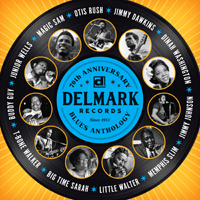
DELMARK RECORDS 70TH ANNIVERSARY BLUES ANTHOLOGY (Delmark 878-1)
Bob Koester was an avid record collector who founded Delmar (later Delmark) Records in 1953 and began to record blues and jazz musicians who appealed to him. These artists have a timeless appeal and though he retired in 2018, Koester's legacy is kept alive by new ownership who have released 30 new albums in the last 5 years and now are looking back over their history for this wonderful compilation that showcases their heritage. There aint a slack track on the front or the back! We open in 1965 with Junior Wells on vocal and harp, featuring Buddy Guy on guitar, with "Snatch it back and hold it" which takes off from James Brown's "Papa's got a brand new bag"; Magic Sam's "All of your love" which has Sam along with Mighty Joe Young on guitar, is a classic laid-back blues, followed by a different song with the same title by Otis Rush. This West Side Chicago blues style, with a kind of a stuttering drag on the notes was influential on Peter Green and Eric Clapton whose early success was due to their ability to cop the note-bending style of Rush, Buddy Guy, Jimmy Johnson and Magic Sam. Some honking sax fills out the sound. Rush sticks around to add some blistering lead guitar beside Jimmy Dawkins as they back up Andrew "Big Voice" Odom on the gem "All for Business," from 1971. Side one ends with Dinah Washington's mellow "Blues for a day" backed by Lucky Thompson's All Stars with Mingus on bass. To me Dinah sounds like Lady Day and Lucky sounds like Lester Young, but feel free to disagree. The B side hits hard with Little Walter and Muddy Waters, T-Bone Walker and Memphis Slim. When Slim sits back on the ivories with two tenor saxes and calls on Murphy to rip out some licks on his guitar we are in Chicago bar-room blues heaven. In the realm of jazz, Bob Koester released some albums by Bud Powell, Sonny Stitt and the Art Ensemble as well as two early albums by Sun Ra, but here the focus is on the smoldering urban blues sound.
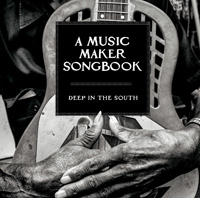
DEEP IN THE SOUTH: A MUSIC MAKER SONGBOOK (Music Maker Foundation)
This is a treasure: an anthology of 27 rural blues songs (& a few electric urban entries to spice it up), recorded recently (in this century), with stories, photos and amazingly, complete transcriptions of the guitar parts, for anyone who can read music, or wants to play along. In the case of the lovely "Going to the Race Track," by Etta Baker, this will be a special treat for anyone reading the tablature. As the Rough Guides to Blues have been getting scratchier and scratchier of late, it's cool to hear some clean and crisp recordings with all the subtle tones of acoustic guitar and voice to the fore. The CD has 19 songs; the download 27, so clearly you have to choose between the physical package and the additional tracks. I started with Taj Mahal's "My Creole Belle," and was surprised to see his entry is a ragtime tune, done in a Piedmont Blues style! But most of the 18 artists are new to me, and many have several selections to showcase their talents. Alabama Slim and Beverly "Guitar" Watkins do sound like people I might have heard, and I know Freddie King, but the artist performing here is Little Freddie King. He is a cousin of Lightnin' Hopkins and styles his blues playing after the real Freddie King. Preston Fulp (born 1915) gives us the chestnut "On the Banks of the Ohio," and his singing strains toward the etherial ghostlike quality of Skip James. Benjamin Tevohal stands out, first because he is a white Frenchman, living in Strasbourg, who grew up loving the blues (like a lot of European kids), and secondly, because he is a one-man band, using a foot to kick a bass drum and cymbal, while using his other foot to play a bass pedal board, while also adding in harmonica to his fine guitar, on an original composition. Meanwhile back in North Carolina, John Dee Holeman has a kick-ass backing band of bass, drums and organ as well as harmonica and his stellar guitar. His cover of Lightnin' Hopkins' 1950 hit, "Shotgun Blues," is chilling. Another Lightnin' hit, "Dew Drop," credited to "trad," is turned into another fine guitar solo by Etta Baker. She was discovered in the 50s and invited to the Newport Folk Festival but her husband refused to let her go. After his death she returned to the guitar. A lot of these musicians are not professional, or working at it full-time, but still have the requisite chops. Jeffrey Scott is a farmer, mortician and long-haul truck driver but he sure has a fine touch on the fretboard. Alabama Slim is from Alabama, but now has a New Orleans accent and a wonderful resonant voice like John Lee Hooker. He plays electric guitar with his thumb so it's quite rudimentary but he gets his point across. "Fannie Mae" is a 13-bar blues in E: it was the lead track on his 2010 album Blue & Lonesome. Another highlight is the roadhouse boogie "Back in Business" performed by Beverley "Guitar" Watkins from Atlanta. She started out with Piano Red in the 1950s. By the mid-60s she was playing with the likes of Ray Charles, James Brown and B.B. King. She has a full band, accompanying her jamming guitar and raspy vocals. Another denizen of the Atlanta blues scene, Frank Edwards, turns in a stirring "Chicken Raid," which he recorded when he was 90! Of Guitar Gabriel's playing, Eric Clapton said, "Oh, my God!" Yes, he is astounding (represented with four selections). And speaking as one of the Eurokiddies who grew up listening to Southern blues, there is a lovely rendition of "Baby Please Don't Go" by the aforementioned Little Freddie King. This album and accompanying photo-illustrated book do a lot to further the cause of Southern folklore.
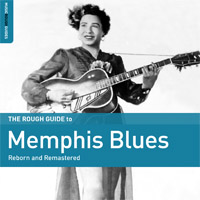
ROUGH GUIDE TO MEMPHIS BLUES (RGNET1411DD)
There is great poetry in the Blues. I only mention this because normally I listen to music in non-English languages which means I can work or read while it is on as the vocals become another instrumental component. As Paul Oliver described it (in The Meaning of the Blues), "these folk blues of the rural South, strong, untutored, but rich in textural variety, moving in expression and frequently accomplished, if unorthodox, in their instrumental accompaniments, are the 'Country Blues'." This latest installment in the "Reborn and Remastered" series compiled by Neil Record for Rough Guide homes in on Beale Street, the Black entertainment district of Memphis Tennessee, lately brought vividly to life by Baz Luhrmann in his Elvis biopic with the African-American musicians of the mid-century represented by B.B. King, Big Mama Thornton, Sister Rosetta Tharpe, Little Richard and Arthur "Big Boy" Crudup (portrayed by Gary Clark Jr). Crudup was a Delta blues guitarist whose "That's all right, Mama" was covered by Elvis. Another memorable filmic cover of Memphis blues was "He's in the Jail House Now," by the Soggy Bottom Boys in O Brother, Where Art Thou? You can hear the 1930 version of this vaudeville number by the Memphis Sheiks on this disc. More sheiks, this time called Beale Street Sheiks give us "Mr Crump don't like it," from 1927. Frank Stokes and Sam Sane (who teamed up in the Beale Street Sheiks) also perform a very intricate duet on "How Long blues." (Rudolph Valentino's The Sheik, 1921, and Son of the Sheik, 1926, were the biggest films of the 1920s.) Memphis was the murder capital of the country and Beale Street the seedy underbelly, with gangsters, gamblers and pimps running the show. Whites fled in the 1870s when Yellow Fever took hold, so poor whites and negroes were left to their own devices. Beale Street, the sinful heart of Memphis, ran from the riverbank to downtown. This was the place where the country met the city: musicians from Mississippi relocated there and many cut their teeth on the streets or in the ranks of the Memphis Jug Band or Cannon's Jug Stompers. The kazoo and washboard sound is so comical we think of R. Crumb and these are definite vaudeville elements where the raw Delta blues meets the performing stage with comic lyrics and fewer heartaches. All the music here was recorded between 1927 and 1934, when Paramount, Victor and Columbia converged on the city to discover Robert Wilkins, Sleepy John Estes and Memphis Minnie, who also has her own dedicated CD in this series (That's her on the cover too). Listen to Estes' sing "The Girl I Love She got Long Curly Hair," and tell me it's not the same riff as "Rollin & Tumblin'," or a dozen other blues songs. This is the fount where Cream and Canned Heat found "Sittin' on Top of the World" and "On the Road Again" (both present here). Furry Lewis and Memphis Minnie are among the outstanding guitarists on display. One of the few thrashed recordings on here is Gus Cannon's classic "Poor Boy, Long Ways from Home." Despite the surface noise the guitar and vocals are clear. And remember, If you don't like my peaches, don't shake my tree!
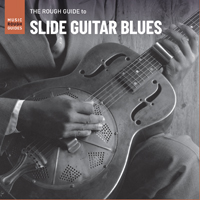
ROUGH GUIDE TO SLIDE GUITAR BLUES (RGNET1420)
Slide guitar, especially bottleneck on a National Steel (as seen on the cover), is the characteristic "voice of the blues." There's an introduction to "Baby please don't go" in Fred McDowell's best-selling 1970 album, I Do not Play no Rock 'n' Roll, where he explains, "I make the guitar say what I'm saying: if i say 'Our father' it'll play 'Our father'... if I play 'Amazing Grace', it'll sing that tune," as he demonstrates the slide, and it does indeed fill in the words. Fred McD & Robert Johnson did not make the cut this time around, which is the third Bottleneck Blues compilation from Rough Guide, but we hear plenty of the singing slide Fred showcased. The liner notes to the disc by compiler Neil Record explain that a wire strung between two pegs and played with a sliding tool such as a smooth bone was a West African child's instrument, known by slaves as the "Diddley bow"! That's a great name and a credible source as one-stringed instruments, such as the njarka fiddle, are still played in Mali. Hawaiian style slide arose at the same time as Mississippi blues, around the turn of the twentieth century and also had an influence in Africa as recordings began to reach there. By the time the great Barbecue Bob died in 1931, aged 29, he had evolved a unique and distinct style making a regular 12-string guitar sound like a prancing harpsichord. Here he gives us "Goin' up the Country" with its fast and stinging choral response, whining back to his dry almost hoarse vocals. Disc one in the series had John Fahey, Bob Brozman, Stefan Grossman and the Genial Hawaiians (not all together), whereas this one is straight ahead Delta blues. And this time Record sticks to the classic 30s sound, before Elmore James that is, from 1926 to 1936, from Blind Willie Johnson to Leadbelly. Gems are brought in from Curley Weaver ("Tippin Tom"), Oscar Woods ("Lone Wolf Blues"), and many others. Son House's "My Black Mama (Part one)" is driving and relentless, reminding us why he is one of the greatest. Blind Joe Reynolds' brilliant "Outside woman blues," made famous by Cream, still has not turned up in a decent version, but we take what we can get. And inevitably some of the tracks have appeared before, notably on Yazoo compilations, but Rough Guide continues to build a monumental library of American blues.
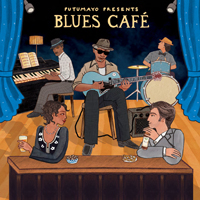
PUTUMAYO PRESENTS BLUES CAFE (Putumayo)
Putumayo is a region in Colombia where once upon a time, Dan Storper, the head of the Putumayo label thought he had found Paradise in a little valley. I just read an article in The New York Times, datelined Putumayo, how the only way for the farmers to survive nowadays is to join the paramilitaries that covertly rule the countryside and control the flow of coca from neighboring Ecuador and Peru. The label continues tranquilly on, however, with its unmistakable faux-naive covers picturing some idealized we-are-the-world type place that surely can no longer be thought to exist. But the music endures. This foray, called Blues Café, presents some familiar artists, like the great Lightnin' Hopkins, Sonny Terry & Brownie McGee, personal favorites Junior Wells and Otis Spann, and throws a couple of lesser-known talents into the mix. Among them are three nonagenarians who will get financial support from the Music Maker Foundation with 5% of the proceeds from this album's sales. Of course if you listen on Spotify or Pandora that 5% wont amount to a gob of spit, but the intention is good. I enjoyed Algia Mae Hinton's "Going down the Road feeling Bad" as her acoustic picking is very sprightly. Most of the tracks are familiar bar-room blues, electric guitar with harmonica, which I suppose is associated with B. B. King, though may as well be attributed to the sound of Buddy Guy or James Cotton, also present here.
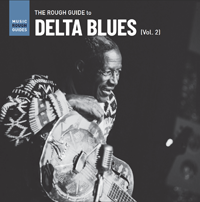
ROUGH GUIDE TO DELTA BLUES VOL 2 (RGNET1417)
Before Rock and Roll there was Rhythm and Blues and before that we had the genuine, unadulterated Delta Blues from Mississippi. From the late 1920s up until the Second World War labels like Paramount sent scouts to small towns looking for talented buskers in juke joints and on street corners. Now we know their names — Son House, Big Joe Williams, Charley Patton, Tommy Johnson, Skip James, Robert Wilkins — but until relatively recently only a few collectors had access to this fabulous music. For the most part we hear a singer/songwriter accompanying himself on the guitar. And we know the lyrics because Mick Jagger, Robert Plant, Alan Wilson of Canned Heat and others echoed them, sometimes lifting them intact from the source, complete with fake southern drawls (Jagger's singing voice is eerily like Don Covay's — just saying). Rough Guide's latest trawl through this genre, compiled by Neil Record, finds some overlooked things. It follows volume 1 (2016) pretty closely in choice of artists: including Arthur Petties, Robert Wilkins, Mattie Delaney, Garfield Akers, Willie "Poor Boy" Lofton and others I would not have thought as "seminal" artists, but it's great to hear more from them. The sound on "Can I do it for you?" by Memphis Minnie and Kansas Joe is so thrashed we assume its source is the only known copy of this recording. But we take a deep breath when it ends and accept the scratchy top end of one of the most haunting voices ever recorded: Nehemiah "Skip" James in full falsetto with the 1931 "Cherry Ball Blues," replete with his hammered-on six-string tails to each line in his unique open D tuning. In addition to Memphis Minnie we are (re)introduced to another woman guitar-picker, Mattie Delaney. Also the great Charley Patton sings "Shake it and break it, sweet mama, but don't let it fall." But again there's a lot of mumbling to disguise the dirty bits. Mississippi Bracey's "I'll overcome some day" may be new to you and me, but the tune is very familiar from "Come on into my kitchen" and other well-known blues. "Maggie Campbell blues" by Tommy Johnson, on the other hand, has familiar lyrics, from "See see, rider, see what you done done: you done made me love you," to "Sun gonna shine in my back door someday," and so on. He has a second guitar and mandolin playing twin leads. We are presented with the purling sounds of Bo Carter giving us "Shake 'em on down," another delight. This collection expands our knowledge of the performers, such as Ishman Bracey, and brings some wonderful tunes to the Delta blues canon (which now includes stomps and hokum in addition to the standard 12-bar blues).
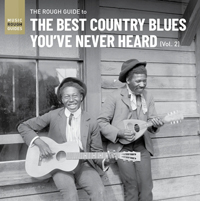
ROUGH GUIDE TO THE BEST COUNTRY BLUES YOU'VE NEVER HEARD VOL 2 (RGNET1414CD)
Rough Guides to the Blues continue at breakneck speed with another volume dedicated to Country Blues, a convenient catchall title for any of the regional blues styles of a century ago. In keeping with the subtitle of "Best you've never heard," Neil Record, the compiler, has assembled two dozen obscure but great tracks, all lovingly remastered to best-possible sonic clarity, to demonstrate that this was a remarkable flowering of (mainly) African-American musical talent between the Depression and World War II. The names are obscure, though sometimes amusing -- Bogus Ben, Skoodle Dum Do & Sheffield -- but the tunes are occasionally familiar, from "Careless Love" to "Stack O'Lee" to "Nobody knows you when you're down and out." This musical well was a source for Canned Heat, Country Joe & the Fish and other sixties American rock bands, so there are many familiar phrases and riffs. Edward Thompson's "Seven Sisters Blues" sounds like another version of "Rolling & Tumbling." Bogus Ben is accompanied by banjo, mouth organ and kazoo; I wonder if he knew the (original) Rooftop Singers who used the same instruments. According to wikipedia Bogus Ben pretended to be blind while busking, hence the "bogus" appellation, and also performed on a mandolin-banjo, which sounds interesting. Another surprise is the stellar clarinet on Will Day's "Sunrise Blues." There are novelty numbers, like "Travelin' Man" and the fake gospel of "G. Burns is gonna Rise again," along with a great rendition of "Easy Winner" by the Blue Boys which is a string arrangement for guitar and mandolin of Scott Joplin's "The Entertainer." It was a famous piano rag, especially after it was sold on pianola rolls in the 1910s, but (wiki again) this was the first recording. Other than a need for some detailed liner notes, the Rough Guide series is superb, and continues to compile exemplary discs.
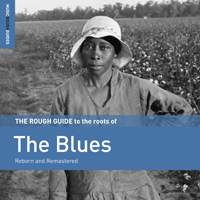
ROOTS OF THE BLUES (RGNET1397DD)
When you think of great series of music in recent times, such as the Nonesuch Explorer series, the Hugh Tracey discoveries on SharpWood, the Angola series (or Ethiopiques if you prefer) on Buda Musique, the Zanzibara series (also on Buda), Stern's Sylliphone reissues, the 20 or so Dakar Sound discs, the Congotronix series on Crammed, or the monumental foundation of Cuban music on Tumbao, it's a wonderful time to be collecting music. One of the great contributions to expanding our musical knowledge has been the Rough Guide series on the Blues. Many of us grew up on this music, listening to Robert Johnson, Son House, Mississippi Fred McDowell, as we were finding albums on Chess, Yazoo, Arhoolie and even more obscure labels. It was a logical development from the pop music of the 60s for anyone interested in where it came from when it became clear that groups like the Rolling Stones were just good cover bands. Once you got back to the original of Cream's "Rolling and Tumbling" or tunes by Canned Heat or Led Zeppelin you discovered a world of riches. In a pattern that was mimicked by African music collectors half a century later, determined fans found copies of rare originals and established a canon of great blues music. We learned "Sweet Home Chicago" by Robert Johnson was also "Kokomo Blues" of Scrapper Blackwell. People claimed Clapton was God until they heard the fingerpicking of Blind Blake. I hope this is not the end of the series. In the past Rough Guide have constantly revised their catalogue so when a Rough Guide to say Mali goes out of print they make a new one and update it. Here they give an expansive 25-track overview of the incredible series they have put together so far, alternating between classic one man and his guitar (or piano) songs and bigger outfits, either jug bands or full-blown jazz ensembles, backing the likes of Ma Rainey or Bessie Smith. It's expansive and all-inclusive so they even squeeze in "Blue Yodel" of Jimmie Rodgers (or Chemirocha as he is known here at Muzikifan). In addition to country there's barrelhouse with Speckled Red's brilliant "Dirty Dozen." Once again the familiar tunes (I never tire of "Statesboro Blues" by Blind Willie McTell) are flanked by delightful obscurities like Victoria Spivey's "TB Blues" (also written by Jimmy Rodgers) accompanied by guitar and piano (No credits here, but i think that's Lonnie Johnson on guitar) and Papa Charlie's banjo jam from 1925 "All I want is a spoonful." Breathtaking, monumental, play it once, you'll play it again.
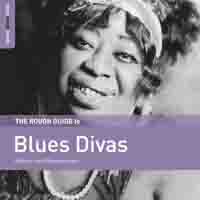
THE ROUGH GUIDE TO BLUES DIVAS (Rough Guide RGNET1392CD)
For another take on the ladies who sang the Blues, Rough Guide has come up with 25 cuts. Often salacious and light-hearted these blues songs were among the most popular and certainly the first "race" records recorded and marketed to an eager public. They are also folk art in the finest sense coming out of vaudeville and bar rooms where the singers were backed by jazz musicians, rather than the more familiar country blues performances with one or two guitars (like Geeshie Wiley & L.V. who are not present). The early divas, Ma Rainey and Bessie Smith, were so influential their impact could still be heard in Billie Holiday, Nina Simone, Mahalia Jackson and Janis Joplin. The Depression killed off the market for a lot of recorded music, so almost all of these sides were waxed in the mid to late 1920s. It's a glorious era, and Rough Guide has attempted to restore the sound though a couple, like the early "St Louis Blues" of Ester Bigeou could have been omitted for quality control. Maggie Jones' "Anybody here want to try my cabbage?" is pretty silly, even if it points the way to "Don't touch me tomato," and similar metonymic grocery ditties. There are no notes (not even the 5 photos are identified) so you will have to dig on your own if you want to know who the accompanists are. Lizzie Miles' "Electrician blues," for example, has fine piano which took a little sleuthing to find was Harry Brooks who also wrote "Ain't misbehavin." There's great trombone and a fine clarinet backing Sippie Wallace's "I'm a mighty tight woman." Turns out to be Johnny Dodds on clarinet and Honore Dutray on the 'bone, both of whom were with King Oliver and Louis Armstrong's bands. The great band backing Lena Wilson, I also learn from discogs, is the Nubian Five (who seem to be Italian-Americans, adding a layer of intrigue: I've heard of "passer blanc" but "passer noir"?). Edith Wilson's "My man is good for nothing but love" but he is "like a dove" and "fits me like a glove," whereas other ladies are pursued by everyone from King Solomon to the Prince of Wales.
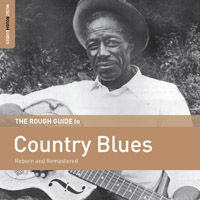
THE ROUGH GUIDE TO COUNTRY BLUES (RG1388)
As an editor I spend hours cutting and pasting, revising and rewriting, reshuffling and pruning. The aim is to present the best version of something with clarity and precision. Rough Guides' editors are constantly in the process of revamping their catalogue: their Rough Guide to the Blues came out in 2007 and spanned the entire genre from Robert Johnson to Muddy Waters, Howlin Wolf and even Ali Farka Touré. A decade later they have refined and specialized to the point of issuing albums of Country Blues Pioneers, Unsung Heroes of Country Blues, The Best Country Blues you've never heard, not to mention albums devoted to bottleneck, gospel, blues women, barrelhouse, etc. Compiler Neil Record's approach for this volume was to include the dozen essential artists in this wide-ranging genre, but to try to present them in a different light and then upgrade the selection to include new must-haves such as the magically eerie Geeshie Wiley, whose amazing story (& three known discs) have only come to light in the last few years. The album is located during the Depression, 1926-36, but most of the material has been restored to sound better than it was before. I compared Robert Wilkins' "That's no way to get along" with the version on Yazoo's Roots of Rock and it is far cleaner, though there is still a lot of audible surface hiss. Maybe a better copy surfaced but also technology is better now (I can attest to this as I spend a lot of time cleaning up African music with Audacity). Ditto with "Spoonful" by Charlie Patton -- the version on Roots of Rock is almost unlistenable. A lot of the material first became more widely known in the 1960s thanks to the slavish devotion of young British guitarists like Clapton, Richards, and Jimmy Page. "Sitting on top of the world" by the Mississippi Sheiks with its wild fiddle lead seems an unlikely contender for rock reincarnation. If you only know "Walk right in" from the folkie 1962 cover by the Rooftop Singers, the raw original with banjo and kazoo solo will crack you up. Familiar tunes include Skip James' "Hard time killing floor" and Barbecue Bob's "Honey you don't know my mind," but there are surprises aplenty from "Cool drink of water blues" by Tommy Johnson to the white songster Dick Justice's "Cocaine" (which, however, was on both Rough Guide to Hillbilly Blues and Rough Guide to Blues Songsters). With concise and informative liner notes (apart from failing to identify Son House on the cover, or the other artists pictured, as usual), this is a brilliant compilation.
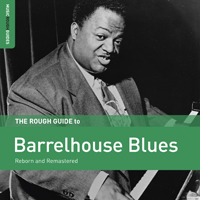
ROUGH GUIDE TO BARRELHOUSE BLUES (RGNET 1375)
The subtitle of this album is "reborn and remastered" and I wish the latter claim was a bit more accurate. Sure, these old discs have seen better times but I have heard Duke Ellington & James P. Johnson 78s remastered from this era that sound brand new. The surface noise is not a deal-breaker but it is a disappointment. These sides were cut between the Depression and the Second World War. The big names are here: "Pinetop" Smith, Meade Lux Lewis, Jimmy Yancey, Cow Cow Davenport, even Skip James who gave up the guitar in disgust when his royalties never came through for the records he made in the certainty they'd be smash hits (as they should have been). He played piano in church and also cut a couple of piano sides, including "If you haven't any hay" as heard here. Victoria Spivey and Louise Johnson (check out her hand-wringing chops and breathless vocal on "On the wall") represent the ladies. Like the more decorous ragtime, which developed at the same time, Barrelhouse emphasized the off-beat, but also added a walking bass which can rip right into the heart of the sound and, if you can keep both hands going independently and fast enough, you have Boogie Woogie. This was adapted by Ray Charles for his hit "Mess Around," further pushing the sound into the mainstream. New to me is "Head rag hop" by Romeo Nelson (1929): "Daddy that gonna make me feel so boogie woogie!" he sings in girly falsetto, -- I know baby, he says. For the most part the selections are instrumental, or heavy on the ivories, so it's a great showcase of the various talents who livelied up the barrel-houses and juke joints of the nineteen-thirties.
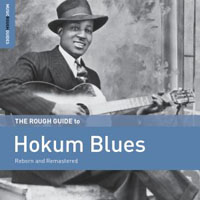
ROUGH GUIDE TO HOKUM BLUES (RGNET1347DD)
Rough Guide continues to carve out a massive history of the blues, a uniquely American folk form as important as jazz in its influence on other cultures and even other art forms. Hokum Blues is dear to my heart (after the nauseating religious stuff) as a light-hearted lyric style that grew out of minstrel acts. We have already been treated to some of the songs on here, on individual albums and other compilations (though you can never tire of Charley Patton's "Shake it and break it"), but this is a wonderful set and one of the best compilations in the series so far. The lyrics are full of innuendo and double-entendre: "draw my cigarette baby until my good ashes come," sings Bo Carter in the lead-off cut. You'll notice the riff which became famous as "Mess around" by Ray Charles. This is followed by the celebrated "Keep on truckin, mama," by Blind Boy Fuller, but you have to listen closely to decipher the lyrics. Bessie Smith however goes overboard in "Need a little sugar in my bowl," with her lyric "need a little hot dog in my rolls" (a wonder she didn't say buns)! Or Lil Johnson's "Sam the hot dog man" when she exclaims "-- I don't mean a weenie!" Half a century ago, when I bought my first blues albums, the selection was pretty scattershot and the sound often atrocious. The rarer the song, it seemed, the more beat-up the reproduction. Now through this ongoing series of Rough Guides we are getting an orderly collection that already amounts to several hundred essential blues track, mostly restored, that everyone should become familiar with.
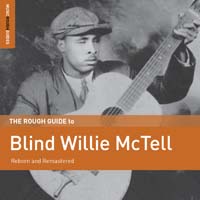
ROUGH GUIDE TO BLIND WILLIE McTELL (RGNET1366CD)
Everyone knows "Statesboro Blues," because it was a huge hit in the rock era, covered by Taj Mahal and then the Allman Brothers. I am speaking of the rock era in the past, and cannot understand why they don't just close the Rock & Roll Hall of Fame, I mean it's done, right? But the Blues lives on and it's a delight to hear two dozen songs with exceptional guitar-playing and witty lyrics delivered in the sweet voice of Willie McTell. The syncopated finger-style picking reminds me of Barbecue Bob, another Piedmontese bluesman who played a 12-string guitar. McTell recorded about 117 songs (including alternate takes), famously "Georgia Rag," (which he recorded as Georgia Bill) and was a successful musician, unlike many retrieved voices from the Delta and Country catalogues who cut two or four sides and vanished. New to me are the duets with his wife Ruth Kate Williams, which are brilliant. Other appealing elements here are the duets with Curley Weaver ("Whip that thing, boy!"), with whom he performed often, though his playing is so intricate he sounds like he is dueting with himself. Sadly, however, McTell was caught in that post-war slack tide when black musicians were ignored and he died in obscurity in 1959 (age about 56) just before the big folk-blues revival that would have gratified his heart after decades of accomplished performances. The original "Stateboro Blues" is one of the most achingly beautiful songs of the late 20s. His wife's snappy comebacks on "Searching the Desert" are also brilliant, although it is essentially a novelty number. Bob Dylan covered McTell's "Broke Down Engine" and paid tribute to him on several of his recordings. English folkie Ralph McTell even took his name! You can hear how his lyrics were influential on many later performers: "I can't be trusted, and I can't be satisfied / when the men see me comin' they go to pinning their women by their side" from "Lord send me an Angel" or "Got three womens: yellow, brown and black... one is Memphis yellow, the other Savannah brown, one of those Statesboro darkskins will really turn your damper down," another three-minute short story from "Three Women Blues." Then there's "the blues came down like dark night showers of rain / I drank so much whiskey I staggered in my sleep / my brain's dark and cloudy, my mind's going to my feet" from "Dark Night Blues". If you look up his complete works King of the Georgia Blues (6 disc set) on discogs, the artists they recommend at the bottom of the page are Neil Young, The Band, Johnny Cash, Bob Dylan and Bruce Springsteen. Safe to say he covered all the bases.
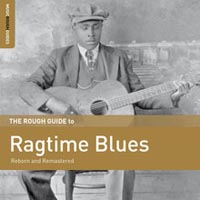
ROUGH GUIDE TO RAGTIME BLUES (RGNET1359)
American blues is a historic movement but nevertheless is in flux. Like other neglected musics of the past the recordings are now scarce and new discoveries, like the work of Geeshie Wiley (as written up deliciously in an extensive New York Times article, which you will forgive me for linking to again, but it's worth reading twice), are continually forcing us to reevaluate the story. So it's Little Wonder (the "Stevie" has been omitted for conciseness and clarity) that compilations like the ongoing series from Rough Guide are as full of revelations as Saint John in his damp Greek b'n'b. When the Beale Street Sheiks sing "Mr Crump don't like it" I thought they were singing about Mr Crumb, that being R. Crumb who collects and proselytizes about early American folk music and blues in particular. If you have seen the documentary about Crumb you will remember the moment when he pulls a Geeshie Wiley 78, "Last Kind Word," out of his shelves of identically grey-sleeved albums and the music blows you away. Well, that was his party piece: he knew the exact disc from some subtle mark because when I met him at home in Willets in the 1970s he pulled the very same act. So Geeshie featured in RG2 Country Blues and here she is again on RG2 Ragtime Blues. I am not complaining but the two categories seem interchangeable to me. Ostensibly ragtime blues attempted to recreate the staggered syncopation of Scott Joplin's piano on the guitar. Also Geeshie's "Pick poor Robin clean" was already on the Rough Guide to Blues Songsters. Her "Eagles on a half" was on RG2 Delta Blues (it's also on an old Yazoo Blues album I own, but I am not sure I could pinpoint its exact location at first try). However I like the random anthology approach because you might buy a Blind Lemon Jefferson or Charley Patton album, having recognized the name, only to find the sound is crap. But in the context of a bunch of other varied-quality tracks you can get the gist of their greatness in a small dose. Outstanding here are Blind Boy Fuller with his virtuoso picking on "Piccolo rag," (I accidentally typed Bling Boy Fuller: how times have changed!) and the crystal clarity of Mississippi John Hurt singing "Got the blues can't be satisfied." The great assured Robert Wilkins cut "Old Jim Canan's" was already on the RG2 Ragtime Blues & Hokum CD, as was the crisply clear and delicate "Cocaine Blues" by Luke Jordan, Willie Walker's "South Carolina Rag," and the great "Ragtime Millionaire" by William Moore. The Blind Blake track was on his Rough Guide CD; likewise the Blind Lemon Jefferson, Blind Boy Fuller and Charley Patton cuts. "Shake me like a dog" by Pillie Bolling (an artist known only by 4 songs) was on RG2 Country Blues 2, so diminishing returns set in. Of course there are unknown gems on here, so if you are budgetary minded you might want to cherry pick the tracks you want from this collection; and eight duplicates from 25 tracks is not a bad return if you don't have the whole set.
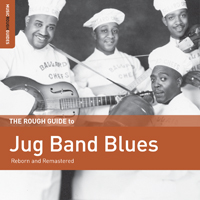
ROUGH GUIDE TO JUG BAND BLUES (RGNET1358)
I'm so glad Rough Guide are continuing their in-depth exploration of the American blues, plus they have done a great job of sound restoration on these pre-1930s Depression-era tracks. The jug bands are the latest category in their anthologizing impulse, and these comprise folks with home-made instruments, like big ceramic jugs you blow into or washboards you scrape like a guiro. The buzzing bomp of the big jug gave a solid backbeat to the performers who were often African-American vaudeville or medicine show acts covering ragtime and jazz as well as blues. Gus Cannon's Jug Stompers are best known but out of the Memphis Jug Band came Memphis Minnie. To spread the joy the Memphis Jug Band recorded under other names on different labels, including the Picaninny Jug Band, the Carolina Peanut Boys and the Memphis Sheiks, whose "He's in the Jailhouse now," leads off the set. (Their "Stealin', stealin'" was later covered by the Grateful Dead.) Slide guitar ace Tampa Red came out of the Hokum Jug Band (who deliver the goods on "It's tight like that," later popularized by Louis Armstrong), while the Birmingham Jug Band produced the harmonica virtuoso Jaybird Coleman. In addition to the Dead you can hear a clear echo of Country Joe & the Fish's "Fixin' to die," in Whistler's "Jug Band Special." Banjo is not frowned upon, indeed it is celebrated in the wild blowout "Banjoreno" by the Dixieland Jug Blowers. The jamming "Beale Street Breakdown" by Jed Davenport blurs the lines between jazz and a hoedown, I guess it's too early to call it Rhythm and Blues. A great varied set, almost all of it unknown as far as I know. I'm glad, I'm glad, I'm glad.
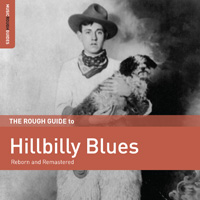
THE ROUGH GUIDE TO HILLBILLY BLUES (RGNET1357CD)
"Race" music was an African-American form aimed at the "black market" in the 1920s, but also garnering fans among white listeners, and just as with rap and hip hop later the inevitable happened: white imitators cottoned on. But white hillbilly musicians, sharecroppers and coal miners, already identified with the struggle in black music and there was an exchange of songs and musical ideas (everyone is black down a coal pit, after all). Listening to this disc it's clear white men can sing the blues: Larry Hensley rips into Blind Lemon Jefferson's "Match Box Blues"; Bayless Blues (race unknown), who was on RG2Bottleneck Blues, renders a jamming "Black Dog Blues." Country duo Darby & Tarleton return from that great compilation also. This is another excellent set from Rough Guide and they keep expanding our knowledge of the regional and stylistic varieties of this form. There are a couple of familiar titles on here ("Stackalee"; "If the river was whiskey"; "Buck dancer's choice") but in versions I didn't know. Dick Justice's uplifting "Cocaine" was anthologized decades ago on various dope madness compilations. Tom Ashley's "Haunted Road Blues" ("I'm worried now but I wont be worried long") even prefigures Hank Williams Jr in an oblique way. You don't need to hear Chris Bouchillon's "Born in Hard luck" more than once -- he plays well but his jive patter is tiresome. Nevertheless there are plenty of gems on here: "Blue Grass Twist" by the South Georgia Highballers has virtuoso guitar. And let's not forget the effect of Jimmie Rodger's yodelling on some Kipsigi girls in Kenya in 1952. When Hugh Tracey played it to them they declared he must be a faun: half-man and half antelope. Such is the mythical power of music. Another dense and rich slice of blues compiled by Neil Record.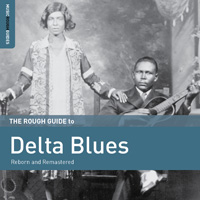
ROUGH GUIDE TO DELTA BLUES (RGNET1353)
Those of us who were raised on rock and roll were keenly aware that the music owed a lot to a major predecessor in the shape of Mississippi delta blues. Bands like Canned Heat, John Mayall's Bluesbreakers, the Yardbirds, and so on padded their repertoire with gems from the likes of Son House, Robert Johnson and Bukka White. The Rolling Stones were formed because Mick and Keith discovered this kid Brian who had a way cooler record collection than them and the only way to get access to his vinyl was to invite him to join the band. Rough Guide continues their exploration of the Blues and they have slowly and methodically built an indispensable library. For this outing, from the rich soil of the delta, instead of the predictable "greatest hits" like "Spoonful," "Roll & tumble blues," "Goin' up country" or "Prodigal son," we have a refreshingly new set of music. Yes we have to have Skip James, whose "Hard time killin' floor blues" is chilling even today, but Robert Johnson is absent. This avoids duplication since everyone in the known universe must have his recordings, but also avoids the controversy over whether his entire oeuvre was mastered at the wrong speed. Recently rediscovered Geeshie Wiley, subject of a great piece of investigative journalism in the New York Times, shows up with the outstanding, if worn-down, "Eagles on a half," one of her handful of recordings, and we hear Memphis Minnie and Mattie Delaney also representing the ladies. That these songs evolved from slave songs and field hollers is evident in the pain with which some of them are delivered with simple strummed guitar, but artists such as Tommy Johnson or the jauntily named Mississippi Sheiks give virtuoso performances on their instruments. On the other hand there is a mesmerizing machine-like monotony to the playing of Rube Lacey. Threadbare poverty and hard lives seep out of the fabric of the songs, "Pack up my suitcase, give me my hat, no use to ask me baby, 'cos i will never be back..." sing the Mississippi Sheiks. "You spent all my money for whisky and gin, mama, don't know how you carry on," adds Jelly Jaw Short. Arthur Pettie, who finds his woman is two-timing him, sings, "That won't do." This music was rediscovered in the 1960s when most of the artists were long dead and it would have all passed into myth were it not for the survival of Skip James and Son House who were lauded, got to perform and reap some of the benefits of their late fame. The songs borrowed from one another also: you will hear Johnnie Temple's "Evil Devil Blues" which is closely related to "Devil got my woman" by Skip James; Charlie Patton's "Poor me" has lyrics which were borrowed for "Sittin on top of the world" by the Mississippi Sheiks; Garfield Akers' chugging "Dough Roller blues" shares phrases with "Roll & tumble." ("I twisted and I tumbled, rolled the whole night long," adds the sublime Miss Wiley.) Beale Street in Memphis was the home of many of these performers until the great migration took them to Chicago where the music evolved into rhythm and blues. It's a fascinating journey.
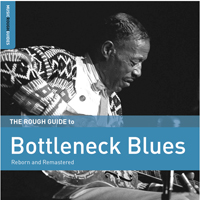
BOTTLENECK BLUES (Rough Guide RGNET1346DD)
If there is one American musical form that is truly imbued with magic it is the Mississippi Delta Blues. While every other form has its hagiographers, its explainers and apologists, the Blues remains a secret society of immutable dark secrets, Shakespearean levels of intrigue and even murder. Alone among American musics that have existed in the recorded era, it still has near-metaphysical puzzles hanging over it. The latest mystery is a third (second to be debunked) purported photo of Robert Johnson. You'd think this would be a minor issue, but fortunes hang on authentication. From the deepest depths of mythology scholars dredge up tales of artists like Geeshie Wiley, a black lesbian guitarist in the Depression who only left a handful of haunted songs. Then another was found, then someone conjectured a connection to another recording and so the legend, worthy of a Brecht opera, is erected. Now, the deck is shuffled again and the devil deals. Here's a shuffle and cut from the top of the deck laying out an incredible run of aces and diamonds (OK, I am gonna squelch this metaphor before I have to bring in spades 'n clubs). Each of these tunes is three minutes long and there are 25 of them here, giving a wide spectrum of styles, all using slide tools on the necks of their guitars. The effect is not unlike some single-stringed West African instruments (& like our beloved African music some of it is in terrible audio shape). Blind Willie Johnson (first of three Blind Willies on here!) kicks off with his gruff delivery of "Nobody's fault but mine"-- the slide echoes his words perfectly as he blends country blues and gospel. The giants of the style are included -- Charley Patton, Bukka White and Son House -- but you will also hear the immensely talented Curley Weaver and a personal favorite, Barbecue Bob. One notable omission is Mississippi Fred McDowell. I remember playing his 1969 album, I Do Not Play No Rock'N'Roll, where he explains how his guitar talks, countless times when it came out. Kokomo Arnold's "The Twelves" was included on the first iteration of this compilation (RGNET1151 2005), here he appears under the moniker Gitfiddle Jim. From the whine of a human voice to a train whistle perfected by the black players, the white country exponents (like also notably absent Roy Smeck) of the slide soon adapted the sounds of the Hawaiian guitar. As well as country duo Darby & Tarleton some real Hawaiians (Jim & Bob) are here: they moved to the mainland seeking fame and fortune. This more expansive style was soon evident in the work of Kokomo Arnold, Casey Weldon, Tampa Red and, new to me, Black Ace. Another nice surprise is Bayless Rose and his "Frisco Blues" from 1930. A quick web search suggests another mystery, no one is even sure of his race. There's room for many noted exponents of the potent form, from Blind Willie (Joe) Reynolds (author of "Outside Woman Blues") to Leadbelly ("C. C. Rider") and Gus Cannon ("Poor boy, long ways from home").
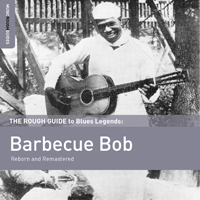
BARBECUE BOB
ROUGH GUIDE TO BLUES LEGENDS (RGNET1328)
Barbecue Bob had a short brilliant career. He first recorded in March 1927, laying down a few sides; more followed in 1928 and 1929 and a dozen in 1930 the year he died (aged 29, from pneumonia). Fifty years later he was rediscovered when the Dutch label Agram released an LP titled Brown-Skin Gal. In the late 70s I met Ray Funk, now a leading authority on Calypso, but in those days Ray was into Blues and Gospel and turned me onto some great stuff including the early Barbecue Bob album. Apart from the clever lyrics, full of double-entendres, Bob (Robert Hicks) had a unique sound because he was playing a 12-string guitar: slide gives way to a wild attack, called "frailing" adapted from claw banjo playing. He became popular because his lyrics were smart, he was a handsome devil (who worked as a BBQ chef, singing to his customers, which is how he became noticed by a Columbia Records talent scout), and his style was more upbeat than contemporaries like Skip James or Son House who sang about the hard times. More songs have surfaced since the 18 sides compiled by Guido van Rijn, and now the count is at 62 or so. Document Records put out a three-volume "Complete" set in 1991. "Motherless Chile Blues" is an important addition, found on the new Rough Guide, but we lose my favorite "Monkey & the Baboon," which is on the "Complete" set with other gems like "She Shook her Gin" (which also appears on the Yazoo compilation Chocolate to the Bone). If you are a blues fan you probably have the Yazoo disc, which is fantastic. Nevertheless this Rough Guide is a great introduction and the sound is wonderful. The Bibliothèque nationale in Paris has digitized some old recordings and these include both sides of a Barbecue Bob 78, so you can compare the quality to those found here. Interestingly the original version of "Honey you're going too fast" (found in Paris) has the same tune on the B-side with different lyrics, "It's a funny little thing." While I like the Rough Guide set I can do without "Jesus' Blood can make me Whole" and certainly some others could have been sacrificed to make room for the cream of his output. But if you don't know Bob this finger-licking set will have you seeking out more of his work, like his duets with his brother Laughing Charley or his final session with Curly Weaver and the Georgia Cotton Pickers (Curly's eerie "No No Blues" -- another take on "Motherless Chile"-- can be heard on the Rough Guide to East Coast Blues). BBQ Bob plays some fast tunes, with a percussive attack, snapping the bass strings and dipping a tasty slide on his little finger into the lead, sounding like two guitars playing at once. "Spider and the Fly" and "Yo Yo Blues" are among the best blues ever recorded, though they may be better characterized as hokum and are full of trebly pop gusto you wouldn't associate with blues.
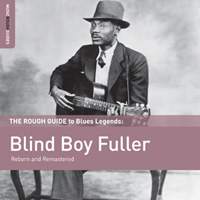
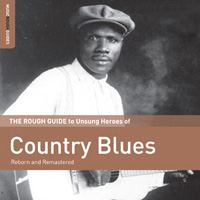
BLIND BOY FULLER
ROUGH GUIDE TO BLUES LEGENDS (RGNET1330 CD)
ROUGH GUIDE TO UNSUNG HEROES OF COUNTRY BLUES (RGNET 1334 CD)
We've heard the Roots of Led Zeppelin, Stoned Alchemy (the roots of the Rolling Stones), even The Roots of Robert Johnson, now Rough Guide seems to be doing an R Crumb-inspired series of American blues. From "Diddy wah diddy" of Blind Blake (RGNET 1303), we now get "Keep on Truckin, mama / truckin my blues away" as the lead cut on the new Blind Boy Fuller release. The 25 remastered tracks here sound (mostly) crisp and clean. Fuller was only 33 when he died in 1940 (reportedly of excessive drinking). However he was a very influential musician in the pre-WW2 era, releasing some 120 sides, including familiar titles like "Get yer Ya Yas out." His finger-picking style was influenced by ragtime and he had some of the tricks of the "hokum" artists up his sleeve too. Born in North Carolina in 1907, Fuller went blind in his teens and took to playing on the streets to survive. He had a tough time, even going to jail for shooting his wife in the leg ("Blind Man with a Pistol" indeed)! In 1935 he was spotted by a record store owner and sent to New York to record. Lines like "I aint had no lovin since my little girl been gone," "I'll give you anything in this whole round world / let me lay it on you," and "You got great big legs and little bitty feet / something about you is sweet sweet sweet" are characteristic of his work and of course survive in Robert Plant and other appropriators' work. He has much in common with Blind Blake both musically as well as in his tragic life story, with a rougher delivery, both in his hoarse vocal style and his brash approach to the National steel resonator guitar. He plays as if he wants to be sure the strings are all there but is capable of ripping out a surprising trilled and pulled ornamental flourish. There is washboard accompaniment (by Bull City Red?) on a few tracks. The style Fuller plays is known as Piedmontese or East Coast Blues, as opposed to Delta Blues. I am glad Rough Guide is pursuing this series as so far it has been a wonderful introduction to some of the lesser-known blues masters of the 1930s.
Simultaneously Rough Guide launches the Unsung Masters disc (appropriately they do not identify the subject of the cover photo!). There are 24 tracks and I had only heard of 4 of the performers before. One of them, Geeshie Wiley, only recorded three discs! I bought the Crumb soundtrack album in order to get her sublime "Last Kind Word" blues. (The B side of that, "Skinny Leg Blues," is also on Crumb.) I have her "Eagles on a half" (1931) on a 1967 Belzona LP compilation called Mississippi Blues 1927-41 that is a fantastic introduction to the Delta. I suppose Geeshie could go in a set of artists with short but brilliant careers like Sir Lord Comic (I think I have 5 by him). This is a stellar compilation (with one or two harsh-sounding cuts) and a lot of variety, though you had probably only ever heard Hambone Willie Newbern before. Here he is with the original "Roll and Tumble Blues" from 1929. "Married Man Blues" by Blind Willie Reynolds is another classic that was covered many times in the rock era by bands like Cream, Blodwyn Pig and Canned Heat. I have it as "Outside Woman Blues" on another crucial vinyl compilation (credited to Blind Joe Reynolds!), Roots of Rock (Yazoo 1063 from 1979), which also features "Roll and Tumble" and other old favorites. I miss the expansive liner notes of the LP, but then who doesn't? These two discs contain some really great and, to me, new music from the interwar years when American "race" music was in the crucible that led to R&B and rock.
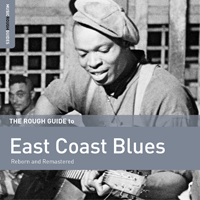
ROUGH GUIDE TO EAST COAST BLUES (RGNET1335)
I was idly spinning the dial on my TV recently and lighted on a program about Eric Clapton. They had a young talking head who was expounding about Clapton's career. "He created a new sound called 'The Woman Tone,'" he said portentously, with the voice of Revelation. --Yes, I replied to noone, as mentioned in the documentary about Cream which we have all seen. "And he was very influenced by the early Blues masters, such as Robert Johnson ... and Blind Willie Dixon." Oh no, I exclaimed. Willie Dixon is blind, how did this happen? as I changed the channel. Unfortunately musical history is often written by ill-informed chumps (Blond Boy Scribbler) like this who write for trade magazines and postulate on the tube. The "woman tone" is a setting which you can hear in Junior Wells and many others' playing, although they didn't give it such a fanciful name. So Rough Guide is here with a proper lesson and once again shade the count on our understanding of the Blues. We all, who don't read SPIN or watch AXS, know about the Mississippi Delta blues and how some of the exponents migrated to Chicago and went electric. The Mississippi Delta blues was born of strife, racial segregation and hard times. The coastal Piedmont region, on the other hand, which spans the Appalachians and runs from Virginia through the Carolinas down to Atlanta, was less segregated, so in this relaxed atmosphere musicians borrowed from one another: ragtime and minstrel or medicine show music informed the blues, as well as a touch of what is known as Hokum music. The big names of this genre are Blind Blake, Blind Boy Fuller and Barbecue Bob and not far behind them are Blind Willie McTell, Rev Gary Davis, Curley Weaver and Brownie McGhee (along with his harp-playing partner Sonny Terry). Blind Willie, in this case McTell, turns in a sensational dialogue with a young lady, called "Mama, let me scoop for you," recorded in 1932, though she assures him she is strictly a 1933 type gal. The restoration on these tracks is superb: a cut above the usual hairy oldies you commonly find in the marketplace. Sighted Willie Moore is new to me and has a nice easy strut (on a 12-string?) that reminds me of Barbecue Bob, who is up next. There are a few familiar tracks on here (some repeated from other recent compilations) but it is always good to hear "She's coming back some cold rainy day" by the Georgia Cotton Pickers, with its rough-sawn rhythm and jagged harmonica counterpoint.

ROUGH GUIDE TO BLUES LEGENDS: BLIND BLAKE (RGNet 1303)
I wish somebody would tell me what "diddie-wah-diddie" means! That line is guaranteed to bring a smile to anyone who remembers R Crumb's ZAP comics. Crumb was famous for his love of early American folk music, he even had a band, the Cheap Suit Serenaders, and drew album covers and collector cards for his favorite old-timey artists. Arthur "Blind Blake" was one of the legendary American bluesmen of the 1930s. Apart from being blind, he died young (at 38), was a hard drinker and had a unique guitar style, which is often compared to ragtime piano. His voice is pleasant and although he was quite popular, recording something like 80 sides for Paramount, there is only one known photo of him (appropriately blurry!). But his songs were his ticket to fame and his style influenced the generation of the 1960s who rediscovered vintage blues, including Ry Cooder, John Fahey and others. "Good to the last drop -- like Maxwell House coffee!" he says of his own playing. It is part of an odd monologue where he discusses his music while performing "West Coast Blues," the B-side of his first record. Right from the start his picking is relaxed, his songs urbane, his delivery conversational. Though when he wants to he can rip it out, like "Southern Rag," where his delivery is astonishingly fast and complex and again he is concentrating so hard his "lyrics" are interjected comments. "I Was Afraid of That" returns to the "Diddie wah Diddie" tune, which is a dancing rag, this time with piano accompaniment. In fact most of his tunes are simple 12-bar blues so you can play along, however, his picking is complex and inventive. There are 26 sides on the Document CD, 23 on the Yazoo "Best of" CD, 23 on the Snapper UK release; there's even a 5-disc box set on JSP that includes all the alternate takes (back-to-back which I find irritating) and his sessions accompanying other singers. I guess that means the music is public domain: some labels clean up the tracks, but one of his greatest songs, "That will never happen no more," always sounds as beat-up as my Kenyan 45s. Rough Guide offer you this as a 25-song download or a 12-track LP; there is a bonus disc called Ragtime Blues & Hokum. Hokum songs are famously double-entendres about sex, like Dave Bartholomew's "My Ding-a-Ling" or songs that suggest grinding meat, boiling hambones or squeezing lemons. This is a good mixture of famous and obscure artists and you will hear familiar songs, like Robert Johnson's "They're red hot," in a new light. And how about this gem: "Say boy can you sing?" "No, I lost my voice in jail. I was always behind a few bars and could never find the key." This disc ends with Blind Lemon Jefferson, who has his own Rough Guide, also in this series (RGNET1298). The sound is so poor though I couldn't listen to it. Again there is a great bonus disc, this one Country Blues Pioneers, a sampler that includes Big Bill Broonzy, Skip James, Tommy Johnson, Robert Wilkins' "That's no way to get along," Memphis Minnie and many others.
Completing their trilogy of sightless Southern singers, Rough Guide gives us the lesser-known Blind Willie Johnson, a Texas preacher who used slide guitar to aid his message. His songs are all of a religious bent and he sings like he could use a bottle of cough syrup. His hits were "Nobody's fault but mine" (No need to mention who covered it) and "John the Revelator," notably covered by Son House. The accompanying bonus disc is less appealing to me personally, being Gospel Blues Legends. I get a little weary of songs like "Jesus' blood can make me whole," even when delivered by the great Barbecue Bob, or Charley Patton's "Oh Death." Again you will recognize the familiar "Jesus gonna make up my dying bed," which I think is called "In my time of dying" by the Zeppelins. The best of these is "Jesus is a mighty good leader" by Skip James which you doubtless already have.
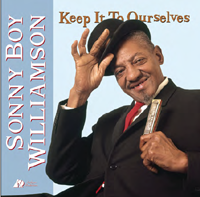
SONNY BOY WILLIAMSON
KEEP IT TO OURSELVES (APO/CAPB 036 SA)
Sonny Boy Williamson II (that is, Rice Miller, the second artist to use this name) was a Mississippi-to-Chicago blues singer and harmonica player, like his namesake who died in 1947. Sonny Boy Two died in his early fifties in 1965. He had minor hits with "Your Funeral and my Trial," and "Eyesight to the Blind," which the Who covered. His "One Way Out" was covered by the Allman Brothers, "Help Me" by Canned Heat; Led Zep remade his wonderful take on Muddy Waters' "Bring it on Home," leading to a lawsuit from Chess records. A couple of years before his death, Sonny Boy toured Europe, recording with both the Yardbirds and the Animals in England. He loved England, where he was adored, and took to wearing a bowler hat and carrying an umbrella, quintessentially English accessories. Famously he said, "Those English boys wanna play the blues real bad -- and they do!" In Copenhagen he recorded two albums which are considered among his best, and a distillation of them has just been reissued by Apo. The very sparse backing musicians are Matt Murphy on acoustic guitar and Memphis Slim on very sporadic piano (who however does sing "Same Girl" with Sonny's harp accompaniment). If you grew up on the aforementioned rock bands who leaned heavily on the real blues, you will find yourself at home with Sonny Boy. He kicks off with Elmore James' "The Sky is Crying," a much more soulful version than those you probably know (The Yardbirds' version was call "The Sun is Shining"). The sound on this is phenomenal, which is great since a lot of it is just his harmonica playing and his gravelly vocals, or Murphy's tastefully discreet acoustic guitar. I could use more Memphis Slim but am grateful for what's here. The main attraction is Sonny Boy sucking and blowing his mouth harp and by jove you are right there.
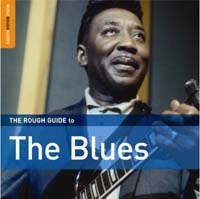
ROUGH GUIDE TO THE BLUES (RGNET 1180CD)
British journalist Nigel Williamson wrote a book called The Rough Guide to the Blues and here is the CD he compiled to distill it to an hour. We've already had Rough Guides to Chicago, Delta and Bottleneck Blues. The Blues squirms around and flows in all directions so there's sub-genres like Oakland Blues and who knows maybe even Big Leg Blues! The Blues we all know and love comes from the Mississippi delta and migrated north to Chicago before blossoming out into popular consciousness in the 1960s in the hands of British rock 'n' rollers like John Mayall and my homeboys the Animals. At first the Blues was the province of female singers and the album opens with Mamie Smith, a red-hot mama for sure, belting it out from 1920. There are four kings and a queen from the delta: Blind Lemon Jefferson, Charlie Patton, Blind Willie McTell, and Robert Johnson, plus Memphis Minnie. McKinley Morganfield [left] was first recorded on the plantation in 1940 by Alan Lomax who was on a field trip for the Library of Congress. Morganfield was confident enough to move to Chicago and start a musical career that became legendary, as he changed his name to Muddy Waters. The killer live version of "Mannish Boy" (a.k.a. "I'm a man") here is definitive proof. In the fifties the sound became thoroughly urban with electric guitar backed by bass, drums and piano as Howlin Wolf and other Chess artists scored hit after hit. (With Willie Dixon on bass and Otis Spann on piano how could you miss?) Significantly artists like Elmore James and Sonny Boy Williamson had a bigger impact on the young white kids of Europe and I was one of those who got exposed to their music as it was covered by rock bands of my generation and then I got to see Bo Diddley, Chuck Berry and many others of that cross-over generation as they toured the English provinces. John Lee Hooker, B.B. King and Buddy Guy began to have a major impact on the popular music of the sixties scoring hits themselves or having their sound covered by the white bluesmen like Clapton, Peter Green, Van Morrison and Long John Baldry. I have a lot of blues albums and compilations (including, of course, my own, with Barbecue Bob, Skip James, Sister O.M. Terrell, Hambone Willie Newbern, Geechie Wiley, etc) but this one really cuts to the essence. Sonny Boy Williamson backed by the Animals takes me right back to cold nights on Percy Street outside the Club A Go-Go before it was all bulldozed to build indoor malls. I won't quibble but the long introduction of the band by B.B. King is a waste of time; but the gratuitous inclusion of Ali Farka Toure is okay. Indeed the "back to Africa" tack has been tried before, for example by Rhino on their Blues Masters vol 10 which opens with Jali Nyama Suso. While I prefer the discoveries you will make if you get the Rhino compilations, this Rough Guide hits all the highlights and is eminently listenable.
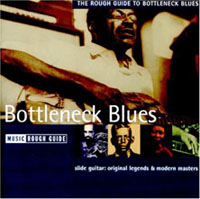
ROUGH GUIDE TO BOTTLENECK BLUES (RGNET 1151CD)
One of the most purely American sounds is bottleneck blues. Despite all the claims to the Malian origins of the Blues there is a uniquely down and dirty sound to music of the Mississippi delta with jangling dobro guitar, scrappy moaning vocals and stinging ringing tones of the glass slide on the neck of the steel-stringed guitar. The meandering tone has an affinity to Hawaiian slide and even Calcutta guitar styles, but then there's the poetry which inspired the rock and rollers of my generation. When the hurricane disaster hit New Orleans I remembered the lyrics of Led Zeppelin's "When the levee breaks" (the original was by Kansas Joe McCoy & Memphis Minnie) & I thought how song lyrics often embody eternal truths in ways you can't get from everyday communications like news or e-mails. And with the ongoing disasters in the American South and the transparent governmental racism toward the poorer coloured folks, these old songs ring truer than ever. The popularity of the guitar among black musicians goes back a century to when the banjo was shunned, being associated with minstrel shows. The appeal of slide guitar is that you don't have to learn chords, you can slide anything -- a knife, a bottle, a comb -- across the open-tuned strings and create a kazoo- or theramin-like rising and falling zooping sound. As the style developed, artists like Fred McDowell would pluck the strings in finger-picking style and keep the slide (a metal tube) on their pinkie which would brush the strings to add grace notes, almost like adding a second instrument. And as you can hear, the talented bottleneck players could use this fluidity of pitch changing to imitate train whistles or even talking! Slide guitar did enter vaudeville, and one of the wonders on here is the dazzling version of "St Louis Blues" by Jim & Bob, the Genial Hawaiians, who were actually a couple of white guys from Chicago. There's a fabulous Bottleneck Masterpiece album on Yazoo (L-1046) called THE VOICE OF THE BLUES which has my favourite novelty slide number, Roy Smeck's 1926 "Laughing Rag." (Actually of the fourteen artists on that LP not one is represented here, which shows you how vast this musical arena is. Two of the Rough Guide tracks, Charlie Patton's "Spoonful" and Hambone Willie Newbern's "Roll & Tumble" which were made famous by Cream, do appear on another Yazoo compilation ROOTS OF ROCK [Yazoo 1063].) This is a great collection of gems from the bottleneck blues repertoire, from Hambone Willie Newbern, Son House and Robert Johnson up to Stefan Grossman and the less-interesting contemporary practitioners Martin Simpson & Bob Brozman. There's enough to engage even a devotee like yours truly.